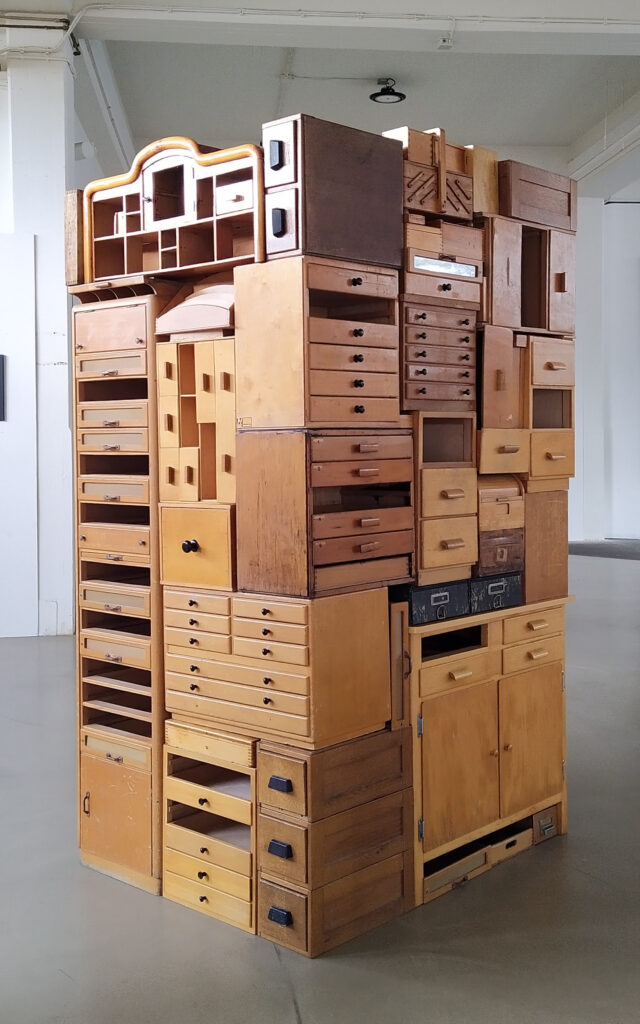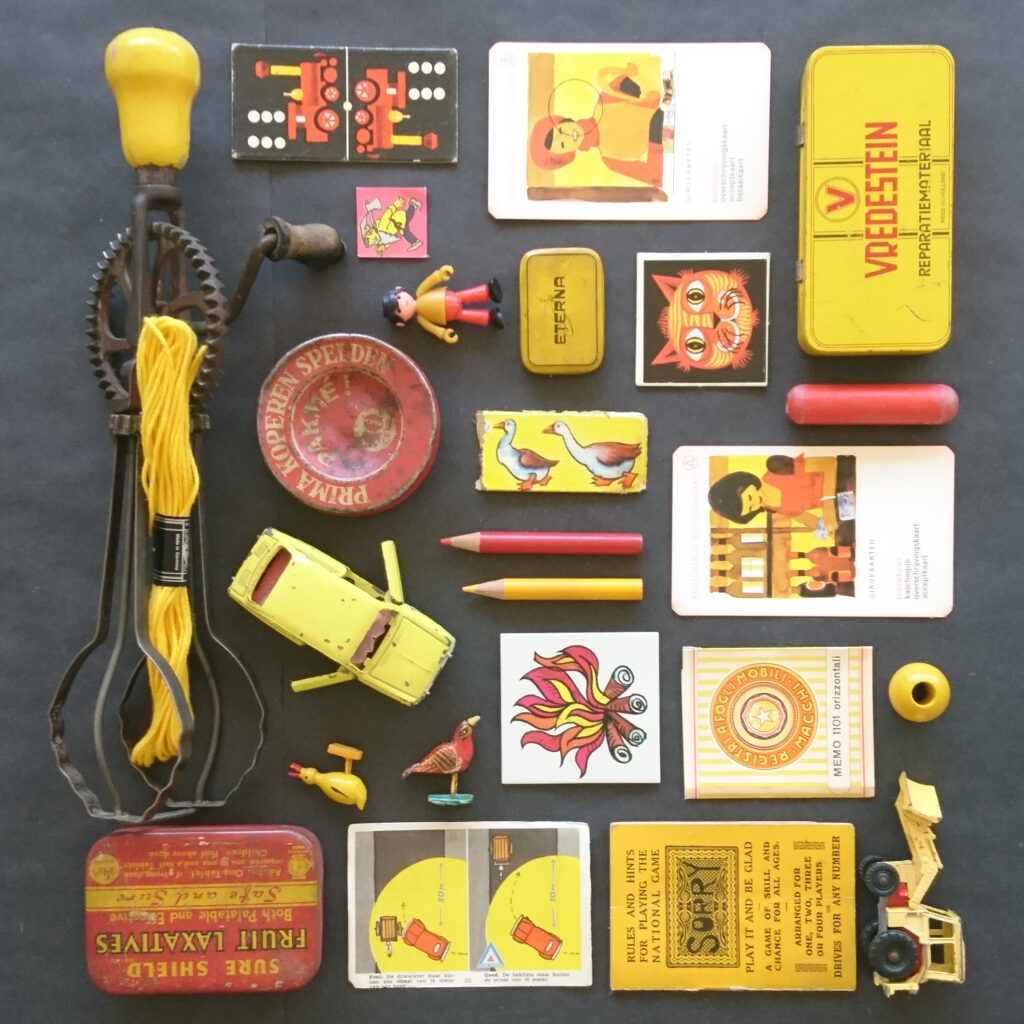Anna van der Putte

Cherishing the beauty of ephemeral objects
“The finding, sorting, and arranging is the basis of everything. Finding treasure, whether in a dumpster or on the street, at the beach or in a thrift store, it is all about the hunt. After that comes the soothing process of sorting and arranging. It is always the broken things I am drawn to. I want the bits that need TLC. When I first started at the studio, I put pressure on myself to go and make some ‘real art’ instead of just sorting and ordering, but I realised after a while that it was precisely that process that was at the core of my art.”
Although she is one of the first artists I connected with on Instagram through collage, Anna does not call herself a collage artist. In her own words, she is a ‘hunter/gatherer’. She has made fragile works as small as 5x7 cm (“A Treasury of Dissolution”) but also exhibited pieces that take up a good proportion of any large room (“Alles uit de Kast”).

Based in Utrecht, The Netherlands, Anna is Dutch, but our afternoon of conversation is in English. Hers is flawless and she has a proper English accent, although she reminds me it is not her native language. She occasionally throws in a Dutch word when there is no appropriate English equivalent. Her attraction to the English language began in childhood when her best friend lived in America. After that, she enjoyed the escapism that the English language offered, a mind travel from her home environment. She went on to study English literature at university.
Upon entering Anna’s studio, you are greeted with a panoramic view of Utrecht. The studio is very full, but it is orderly, and things are arranged by type of material. There are drawers and boxes, many of them. Artwork is on display, and items are thoughtfully displayed on the windowsill. It feels like entering into a different world or time. This studio is where Anna feels held, safe and at ease.
Putting things in order
“As a child, I enjoyed putting things in order and making order. My dad sometimes travelled for work, in the seventies, and my favourite souvenir would be the dinner sets from the airplane, anything neatly portioned in a plastic wrapper. I would spend a lot of time sorting and arranging these objects. My dad also had a workshop, and it is definitely where my fascination and appreciation for mechanical things began.”
"I know instinctively what I am looking for and I go with what speaks to me – shape, color, or material."
“In 2018, I was on holiday in a very basic cottage in Devon, situated right on the beach. I knew I could find beautiful flat slate stones because I had been there before. I was very ill with a burn-out at that time, and for two weeks, I did nothing but look for stones, sort them, arrange them, take photographs, and put them on Instagram. I ignored the kids a lot. (laughing) It was the most wonderful art project I had ever done, and profoundly healing.”
“Instagram helped me enormously. ‘Friday Flatlay’ was a popular thing at that time, and I would say that it was instrumental in my creative recovery. I would decide on a particular shade of green and then look for objects and arrange them. Once I had taken a photograph, I would return every object to its place. The process took me maybe 15 minutes. I shared my flatlays on Instagram and found a receptive community.”

“The flatlays were a turning point. I did not see them as art, it was just me ‘playing with my stuff’ – which is of course the same thing,” Anna says, smiling. “I have learned to trust my gut feeling, and playing is all I do now. I am moving away from making things with a defined format or purpose, from considering “what will people think”. Now I find uselessness more interesting, and rather than a functional purpose I might explore trying to catch emotion. I know instinctively what I am looking for and I go with what speaks to me – shape, color, or material.”
A sense of belonging
“I am an artist. It took me roughly 25 years to be able to say that. I finally fully realized it about four years ago, and it was my studio space and my art itself that convinced me. Throughout my life it has been hard for me to silence the critical voice in my head. But now I had gathered all this beauty; the evidence was staring me in the face. It is as if the artworks were telling me: ‘stop doubting yourself, you made us’.” Through her art, she began to find a greater sense of self-worth and belonging, a calmness and a certainty that she had never felt before.
"There is a sense of belonging when I make an assemblage that pleases me. I rescue worn and old pieces, and they find their family within my art practice."
“My art fills me with such joy. It often doesn't even feel like something that I have consciously made. The objects and materials seem to have a will of their own, and all I need to do is listen carefully.” As an artist and caretaker (and caregiver) of the objects and creations she assembles, she is entirely sure of her work. It is in the studio that her vulnerability becomes a superpower.

“The objects I find are orphans, and I rescue them and care for them until it is time for them to leave. When a particular object that I have been treasuring for years happens to be the perfect fit in a piece I’m creating; well, that feels wonderful, and it means I can let it go. There is a sense of belonging when I make an assemblage that pleases me. I rescue worn and old pieces, and they find their family within my art practice.”
Worth versus value
Triggered by a call for miniature art, Anna ended up making 175 pieces of 5x7 cm for “A Treasury of Dissolution”. Discolored paper, vintage photos, dried flowers and leaves, frayed textiles, small mechanical pieces covered in dust or rust: these are all typical components of Anna’s assemblages. Although the composition of objects may seem incongruent at first, when you look closer you will see the regard for fragility and transience, an homage to ageing and the passing of time. These works are a relief at a time when society is obsessed with consumerism and constant innovation.
“A lot of my work needs to be touched; not by everyone, and certainly not by too many people, but it is not made to sit behind glass. It is not easy to sell or put a price on this kind of work. Some of it is fragile, and there is in any case a vulnerability around the selling of art. The value of the work comes down to the heart and soul I put into creating it. So, I price according to my feeling about the work, and how ready I am to let it go. I view selling my art as an exchange of value, first and foremost – money is only one aspect of that exchange.”
“I love using old, worn things. Perhaps it is a way of reassuring myself that as we become old and vulnerable, our value does not diminish. There is always beauty to be found when you look closely, when you slow down. I have an art wall in my house, mostly of pieces I have exchanged with other artists. When I am old, I can't think of anything nicer than viewing that collection of value from the comfort of my chair.”
This article was featured in issue 39 of Kolaj magazine.